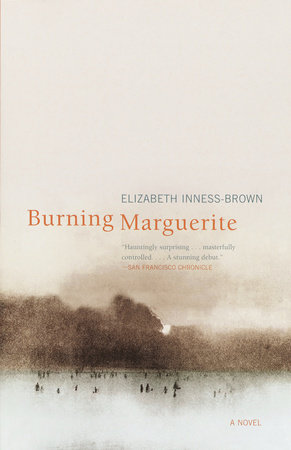Burning Marguerite Reader’s Guide
By Elizabeth Inness-Brown


1. The book opens with an italic passage in an as-yet-unidentified voice. What is different about how this passage is read when beginning the book, and how it is reread after having finished the book? Is the novel meant to be circular, returning to its own and its characters’ beginnings?
2. Inness-Brown has chosen a quote from Puritan poet John Milton for the epigraph: “I cannot praise a fugitive and cloistered virtue, that never sallies out and sees her adversary, but slinks out of the race, where that immortal garland is to be run for, not without dust and heat.” To which characters or aspects of the novel might this quote refer? Is it related to the Sheriff’s insight that James Jack, like Marguerite, was “just this side of wrong but always in the right” [p. 232]?
3. What was Marguerite intending to do when she left the house on the night of her death? How did her intention relate to what she had instructed James Jack to do for her in lieu of a conventional funeral? Why does James Jack, at first, go to the sheriff’s office to report Marguerite’s death [pp. 9–13], and why does he change his mind?
4. Comment on the novel’s structure, which alternates chapters narrated in first person (Marguerite’s story) and third person (James Jack’s story). Why does Marguerite’s story move backward in time while James Jack’s moves forward?
5. Why is the scene of James Jack’s refusal to eat, and Marguerite’s convincing him finally to try eating the petals of flowers from her garden, so moving [pp. 136–39]? Why is this scene revisited in the imagery of the flames of Marguerite’s funeral pyre on the book’s final page?
6. When they first make love, James Jack tells Faith it’s been eight years since he’s been with a woman, and the reason he gives for his celibacy is “Tante” [p. 27]. What is the nature of the bond between James Jack and Marguerite? Was Marguerite right in saying that his bond with her prevented him from finding a love of his own?
7. Marguerite reflects on her relationship with Judith, the woman in New Orleans who encouraged her to sell her drawings. On page 124, she says, “Did Judith and I become lovers? We were intimate in every way—intellectually, emotionally. We gave each other the solace of affection when it was needed; we lay down together when we were cold or lonely. We loved each other; therefore, we were lovers. Whether we crossed that final boundary or not is irrelevant, and no one’s business but our own.” What is the effect of this statement? Is Marguerite’s reticence unusual in a first-person narration? Or does it simply underscore her deep instinct for privacy, despite the fact that she is the narrator?
8. What is the significance of the struggle between Marguerite, the sheriff, and the sheriff’s wife? Why does Inness-Brown choose to set this novel within the context of infertility and its anguish? How does Marguerite claim her moral right to be James Jack’s surrogate parent?
9. Does the story seem to offer hope that the love between Faith and James Jack will be lasting, and will provide a haven for each of them?
10. Elizabeth Inness-Brown has said of Burning Marguerite, “It’s as much a book of place as a book of character” (see Author Q&A). What details bring Grain Island to life in the novel? Which details of life on the island provide the reader with a strong sense of what it would be like to live there? In what ways does the place act as a character?
11. How do the italicized sections function, and what kind of a story do they tell? How are they different from the regular chapters in which Marguerite narrates in the first person? Are they more lyrical in style than the balance of the novel? Why?
12. How surprising are the revelations in Chapter Six about Marguerite’s lover and his murder by her father, as well as the forced abortion by order of her enraged mother? Do you believe that the mother was complicit in the sterilization of Marguerite, or only the abortion? Is it significant that Inness-Brown carefully constructs her novel so that it is framed by extremes of both love and hate?
13. Marguerite is an extraordinary character; what qualities make her so? Is her fierce independence the result of her early trauma with her family? What motivates her to keep her parents’ crimes a secret?
14. Why does Inness-Brown repeat scenes of fire and ice? How do the novel’s central images of fire and ice function? What do they symbolize?
15. The entire novel functions in part as a memoir of a life, told by a very old woman. How does memory serve Marguerite? Is she at peace with the choices she made in her life? What compels her to tell her story?
Just for joining you’ll get personalized recommendations on your dashboard daily and features only for members.
Find Out More Join Now Sign In